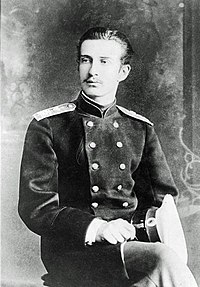Grand Duke Nicholas Konstantinovich of Russia
You can help expand this article with text translated from the corresponding article in Russian. (July 2012) Click [show] for important translation instructions.
|
| Grand Duke Nicholas Constantinovich | |
|---|---|
 | |
| Born | 14 February 1850 Saint Petersburg, Russian Empire |
| Died | 26 January 1918 (aged 67) Tashkent, Russian Turkestan |
| Burial | St. George's Cathedral, Tashkent |
| Spouse | Nadezhda Alexandrovna Dreyer |
| Issue | Prince Artemy Nikolayevich Romanovsky-Iskander Prince Aleksandr Nikolayevich Romanovsky-Iskander |
| House | Holstein-Gottorp-Romanov |
| Father | Grand Duke Constantine Nikolaevich of Russia |
| Mother | Princess Alexandra of Saxe-Altenburg |
Grand Duke Nicholas Constantinovich of Russia (14 February 1850 – 26 January 1918) was the first-born son of Grand Duke Konstantin Nikolayevich and Grand Duchess Alexandra Iosifovna of Russia and a grandson of Nicholas I of Russia.
Early life[edit]
Born in St Petersburg in the middle of the nineteenth century into the House of Romanov, he had a very privileged childhood. Most royal children were brought up by nannies and servants so by the time Nikolai had grown up he lived a very independent life having become a gifted military officer and an incorrigible womanizer. He had an affair with a notorious American woman Fanny Lear. In a scandal related to this affair, he stole three valuable diamonds from the revetment of one of the most valuable family icons. He was declared insane and he was banished to Tashkent.[1]
Later life[edit]
He lived for many years under constant supervision in the area around Tashkent in the southeastern Russian Empire (now Uzbekistan) and made a great contribution to the city by using his personal fortune to help improve the local area. In 1890 he ordered the building of his own palace in Tashkent to house and show his large and very valuable collection of works of art and the collection is now the center of the state Museum of Arts of Uzbekistan. He was also famous in Tashkent as a competent engineer and irrigator, constructing two large canals, the Bukhar-aryk (which was poorly aligned and soon silted up) and the much more successful Khiva-Aryk, later extended to form the Emperor Nicholas I Canal, irrigating 12,000 desyatinas, 33,000 acres (134 km2) of land in the Hungry Steppe between Djizak and Tashkent. Most of this was then settled with Slavic peasant colonisers.[1]
Nikolai had a number of children by different women. One of his grandchildren, Natalia Androsova, died in Moscow in 1999.
Death[edit]
Nikolai died of pneumonia on 26 January 1918.[2] He was buried in St. George's Cathedral (later demolished by the Soviet regime).
Family[edit]
Nikolai married Nadezhda (variantly spelled Nadejda) Alexandrovna Dreyer (1861–1929), daughter of Orenburg police chief Alexander Gustavovich Dreyer and Sophia Ivanovna Opanovskaya, in 1882. Two children were born from this marriage:
- Artemi Nikolayevich Prince Iskander (or Prince Romanovsky-Iskander) (1883–1919), killed in the Russian Civil War
- Alexander Nikolayevich Prince Iskander (15 November 1887 N.S. – 26 January 1957), married Olga Iosifovna Rogovskaya / Rogowska (1893–1962) on 5 May 1912. The couple had two children. Alexander and Olga were later divorced, and Alexander married Natalya Khanykova (30 December 1893 – 20 April 1982) in 1930. No children resulted from the latter marriage.
- Prince Kirill Romanovsky-Iskander, adopted name (via stepfather, Nicholas Androsov) Kirill Nikolaevich Androsov (5 December 1914 – 1992)
- Natalya Alexandrovna Princess Romanovskaya-Iskander, adopted name Natalya Nikolaevna Androsova (2 February 1917 – 1999)
Honours[edit]
 Russian Empire:
Russian Empire:
- Knight of St. Andrew, 14 February 1850
- Knight of St. Alexander Nevsky, 14 February 1850
- Knight of St. Anna, 1st Class, 14 February 1850


 Ernestine duchies: Grand Cross of the Saxe-Ernestine House Order, November 1858[3]
Ernestine duchies: Grand Cross of the Saxe-Ernestine House Order, November 1858[3] Oldenburg: Grand Cross of the Order of Duke Peter Friedrich Ludwig, with Golden Crown, 15 March 1863[4]
Oldenburg: Grand Cross of the Order of Duke Peter Friedrich Ludwig, with Golden Crown, 15 March 1863[4] Grand Duchy of Hesse: Grand Cross of the Ludwig Order, 10 May 1865[5]
Grand Duchy of Hesse: Grand Cross of the Ludwig Order, 10 May 1865[5] Kingdom of Prussia:[6]
Kingdom of Prussia:[6]
- Knight of the Black Eagle, 4 October 1864
- Grand Cross of the Red Eagle, 4 October 1864; Knight 3rd Class with Swords on Black Band with White Edge, 1874
- Grand Commander's Cross of the Royal House Order of Hohenzollern, 7 May 1873
 Saxe-Weimar-Eisenach: Grand Cross of the White Falcon, 1868[7]
Saxe-Weimar-Eisenach: Grand Cross of the White Falcon, 1868[7] Württemberg: Knight of the Military Merit Order, 5 March 1874[8]
Württemberg: Knight of the Military Merit Order, 5 March 1874[8]
 Austria-Hungary: Grand Cross of the Royal Hungarian Order of St. Stephen, 1874[9]
Austria-Hungary: Grand Cross of the Royal Hungarian Order of St. Stephen, 1874[9] Principality of Montenegro: Grand Cross of the Order of Prince Danilo I[10]
Principality of Montenegro: Grand Cross of the Order of Prince Danilo I[10]
Ancestry[edit]
References[edit]
- ^ a b Manaev, G. (8 August 2018). "4 sex scandals in the Romanov family". Russia Beyond the Headlines. Retrieved 29 January 2020.
- ^ Massie, Robert K. (1995), The Romanovs: The Final Chapter, London: Random House, p. 255, ISBN 0-09-960121-4
- ^ Staatshandbücher für das Herzogtums Sachsen-Altenburg (1869), "Herzogliche Sachsen-Ernestinischer Hausorden" p. 21
- ^ Hof- und Staatshandbuch des Großherzogtums Oldenburg: 1879. Schulze. 1879. p. 31.
- ^ Hof- und Staats-Handbuch des Großherzogtum Hessen (1879), "Großherzogliche Orden und Ehrenzeichen" p. 11
- ^ "Königlich Preussische Ordensliste", Preussische Ordens-Liste (in German), 1, Berlin: 6, 21, 934, 1886
- ^ Staatshandbuch für das Großherzogtum Sachsen / Sachsen-Weimar-Eisenach (1874), "Genealogie", p. 14
- ^ Hof- und Staats-Handbuch des Königreich Württemberg (1907), "Königliche Orden" p. 65
- ^ "A Szent István Rend tagjai" Archived 22 December 2010 at the Wayback Machine
- ^ Acović, Dragomir (2012). Slava i čast: Odlikovanja među Srbima, Srbi među odlikovanjima. Belgrade: Službeni Glasnik. p. 628.
